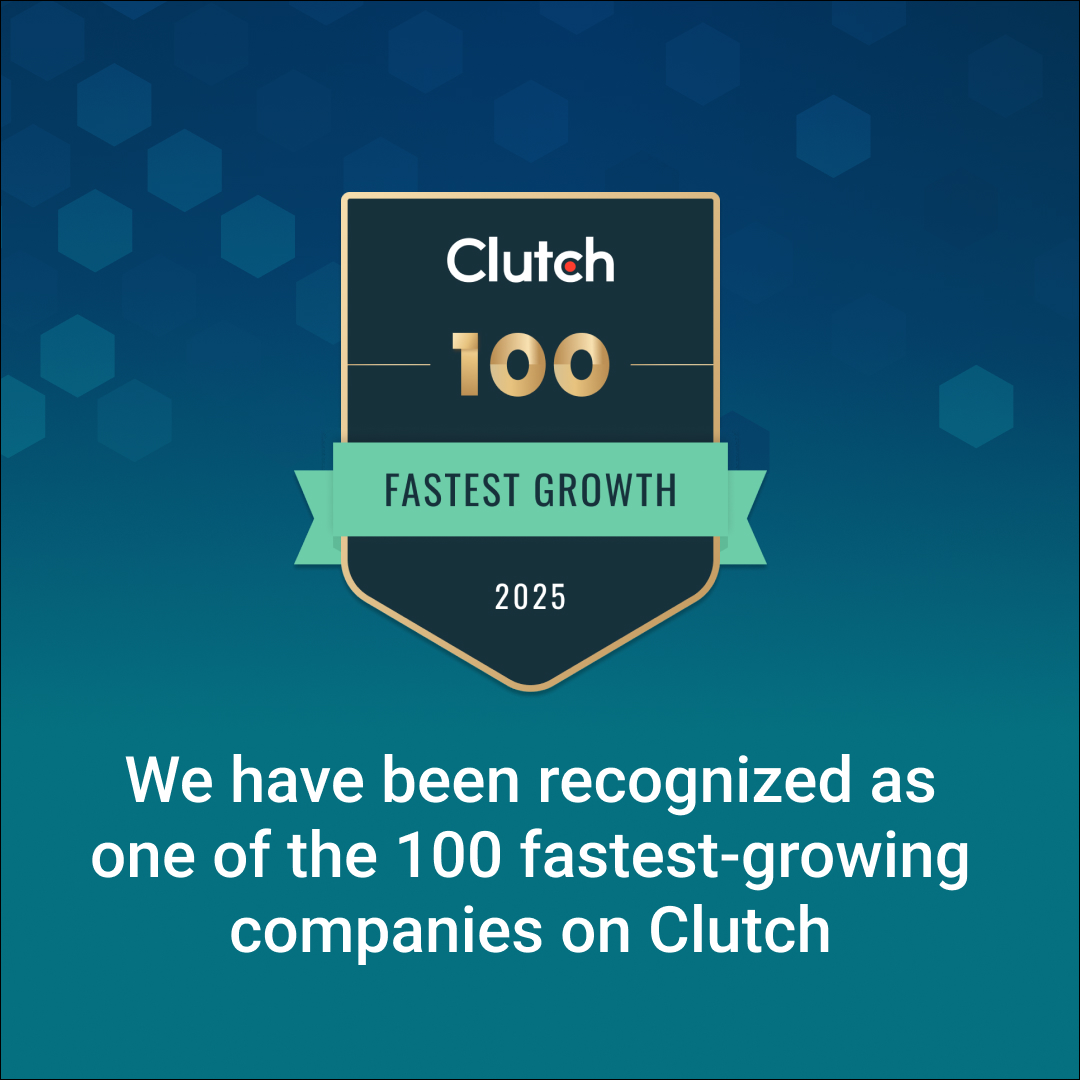Introduction
In today’s competitive landscape, enterprises are increasingly turning to Artificial Intelligence (AI) to enhance operational efficiency, improve customer experiences, and drive innovation. With AI, businesses can automate processes, make data-driven decisions, and create new opportunities for growth.
This guide delves into how AI is reshaping enterprise operations across various industries, highlighting key use cases and challenges that organizations face in adopting this transformative technology.
What is AI and Why Does It Matter in Enterprise?
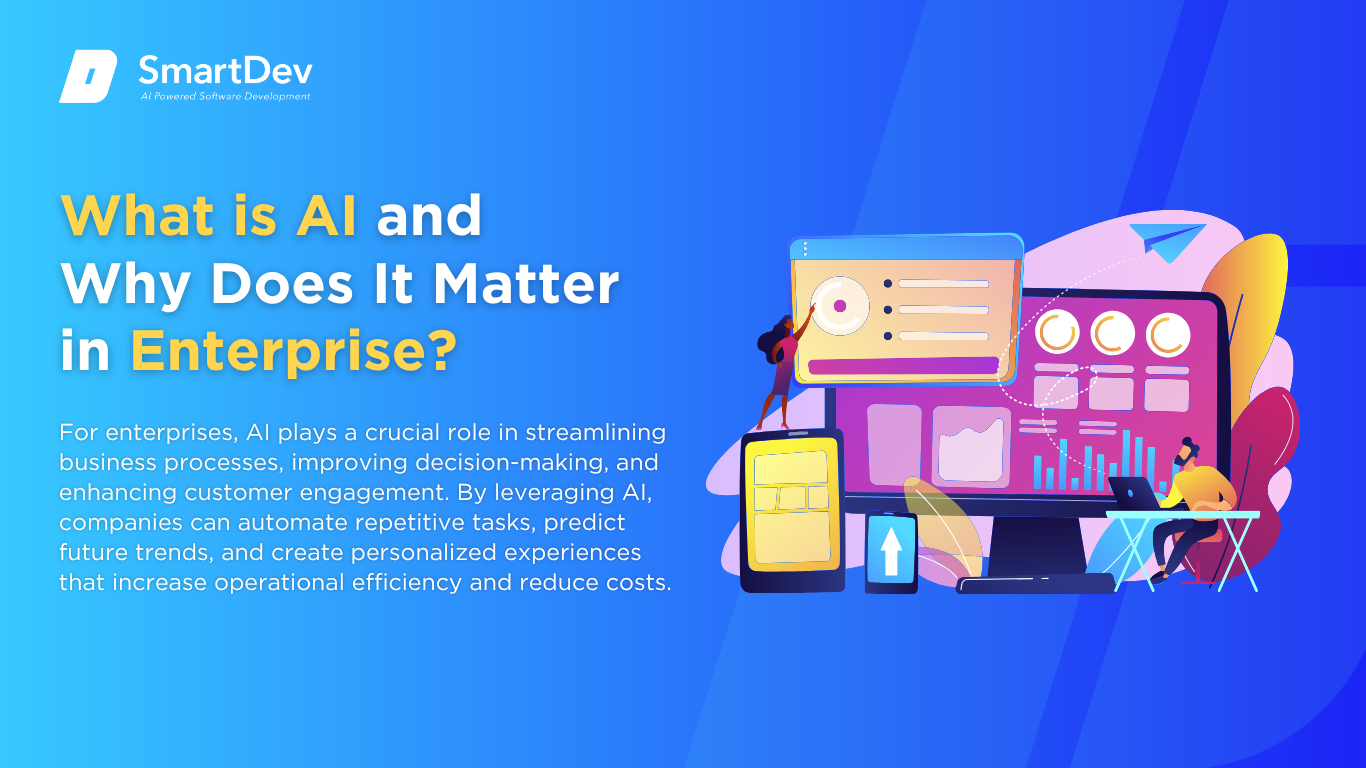
Definition of AI and Its Core Technologies
AI refers to the ability of machines to perform tasks that traditionally require human intelligence, such as decision-making, learning, and problem-solving. Core AI technologies include machine learning (ML), natural language processing (NLP), computer vision, and robotics. These technologies enable AI systems to analyze large datasets, understand patterns, interact with humans, and automate complex tasks.
For enterprises, AI plays a crucial role in streamlining business processes, improving decision-making, and enhancing customer engagement. By leveraging AI, companies can automate repetitive tasks, predict future trends, and create personalized experiences that increase operational efficiency and reduce costs.
The Growing Role of AI in Transforming Enterprises
AI is evolving from a niche technology to a fundamental business tool, helping enterprises in various sectors, from finance and healthcare to manufacturing and retail. AI can automate tasks such as data entry, invoicing, and customer service, freeing up employees to focus on more strategic, value-driven activities. It also enhances data analysis, enabling businesses to make more informed, timely decisions that drive better outcomes.
Beyond automation, AI is driving innovation within enterprises by enabling new business models and services. For example, AI is helping companies build intelligent products, enhance supply chain management, and create new ways to engage with customers. The growing capabilities of AI are pushing organizations to rethink their operations, improve internal efficiency, and deliver better products and services.
Key Statistics and Trends in AI Adoption in Enterprise
AI adoption is accelerating across industries as organizations seek to drive operational efficiency, enhance customer experiences, and innovate with data-driven insights. According to a 2024 report from McKinsey & Company, 75% of enterprises have implemented AI solutions in at least one function, with customer service and operations being the leading areas of adoption. This trend is expected to continue, with 80% of companies planning to increase their AI investments by 2026.
A 2023 Gartner report shows that AI-powered automation has helped enterprises reduce operational costs by up to 20-30%, particularly in back-office functions such as finance, HR, and supply chain management. Automation tools, including AI chatbots and process automation, are improving productivity and allowing businesses to scale more efficiently while reducing the need for manual intervention.
The global market for AI in enterprise applications is also growing rapidly, with Grand View Research projecting the market size to expand from $28.4 billion in 2023 to $280 billion by 2030, growing at a CAGR of 34.5%. This growth is driven by increasing demand for predictive analytics, AI-powered decision-making tools, and personalized customer experiences that enable businesses to stay competitive in rapidly evolving markets.
Business Benefits of AI in Enterprise
AI provides substantial value to enterprises, addressing key challenges such as operational inefficiency, data overload, and the need for personalized customer experiences. Below are five major benefits of AI adoption in enterprises:
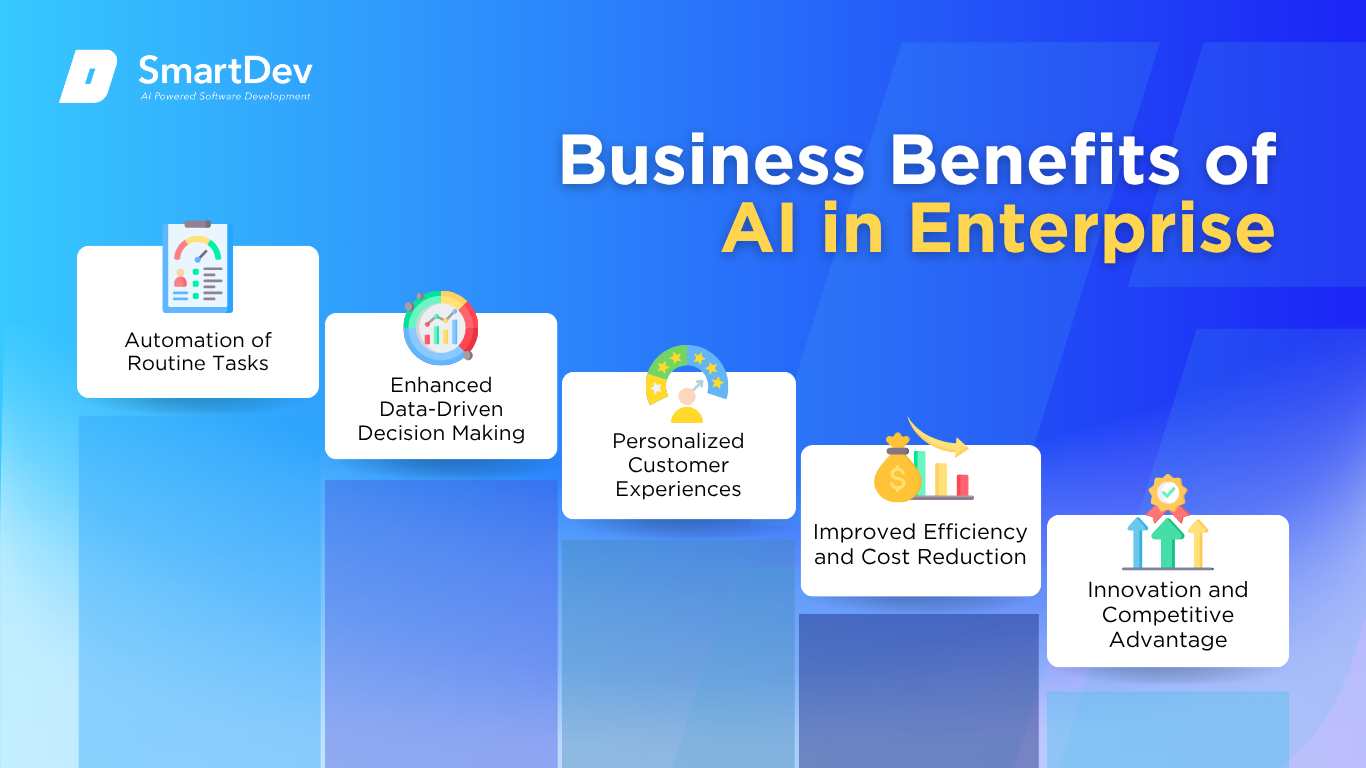
1. Automation of Routine Tasks
AI enables enterprises to automate mundane and repetitive tasks, such as data entry, document processing, and customer service inquiries. By automating these tasks, businesses can reduce labor costs, improve accuracy, and accelerate operational workflows.
For example, AI-driven tools can automatically process invoices, reducing human error and speeding up the accounts payable process. This not only saves time but also enhances accuracy in financial transactions, ultimately improving overall business efficiency.
2. Enhanced Data-Driven Decision Making
AI systems can analyze vast amounts of data to identify trends, correlations, and actionable insights. By using AI for data analysis, businesses can make more informed decisions, whether it’s optimizing supply chains, personalizing marketing campaigns, or predicting customer behavior.
With AI-powered analytics, companies can leverage real-time data to forecast market trends, improve inventory management, and enhance strategic planning. This data-driven approach enables enterprises to make faster, more accurate decisions that drive growth and competitiveness.
3. Personalized Customer Experiences
AI enhances the customer experience by providing tailored, personalized interactions. By analyzing customer data, AI can recommend products, optimize service delivery, and create customized offers that cater to individual preferences.
For instance, AI chatbots and virtual assistants can provide 24/7 customer support, resolving queries and offering assistance based on previous interactions. This not only improves customer satisfaction but also enhances loyalty by providing a more relevant, engaging experience for each customer.
4. Improved Efficiency and Cost Reduction
AI helps enterprises streamline their operations, reducing inefficiencies and lowering operational costs. By automating tasks, optimizing workflows, and predicting maintenance needs, businesses can achieve higher productivity at lower costs.
In sectors like manufacturing, AI-powered predictive maintenance helps prevent costly equipment failures by forecasting when machines need service, minimizing downtime, and extending the lifespan of critical assets. This leads to significant cost savings and greater operational uptime.
5. Innovation and Competitive Advantage
AI drives innovation by enabling the development of new products, services, and business models. Enterprises can use AI to explore new revenue streams, create intelligent products, and deliver value in ways that were previously impossible.
AI can help companies stay competitive by analyzing customer feedback, market trends, and emerging technologies. This allows businesses to adapt quickly to changing market demands, launch innovative products, and deliver exceptional value to customers.
Challenges Facing AI Adoption in Enterprise
While AI offers numerous benefits, its implementation in enterprise environments comes with several challenges. Below are some of the key obstacles businesses must overcome to effectively leverage AI technologies.
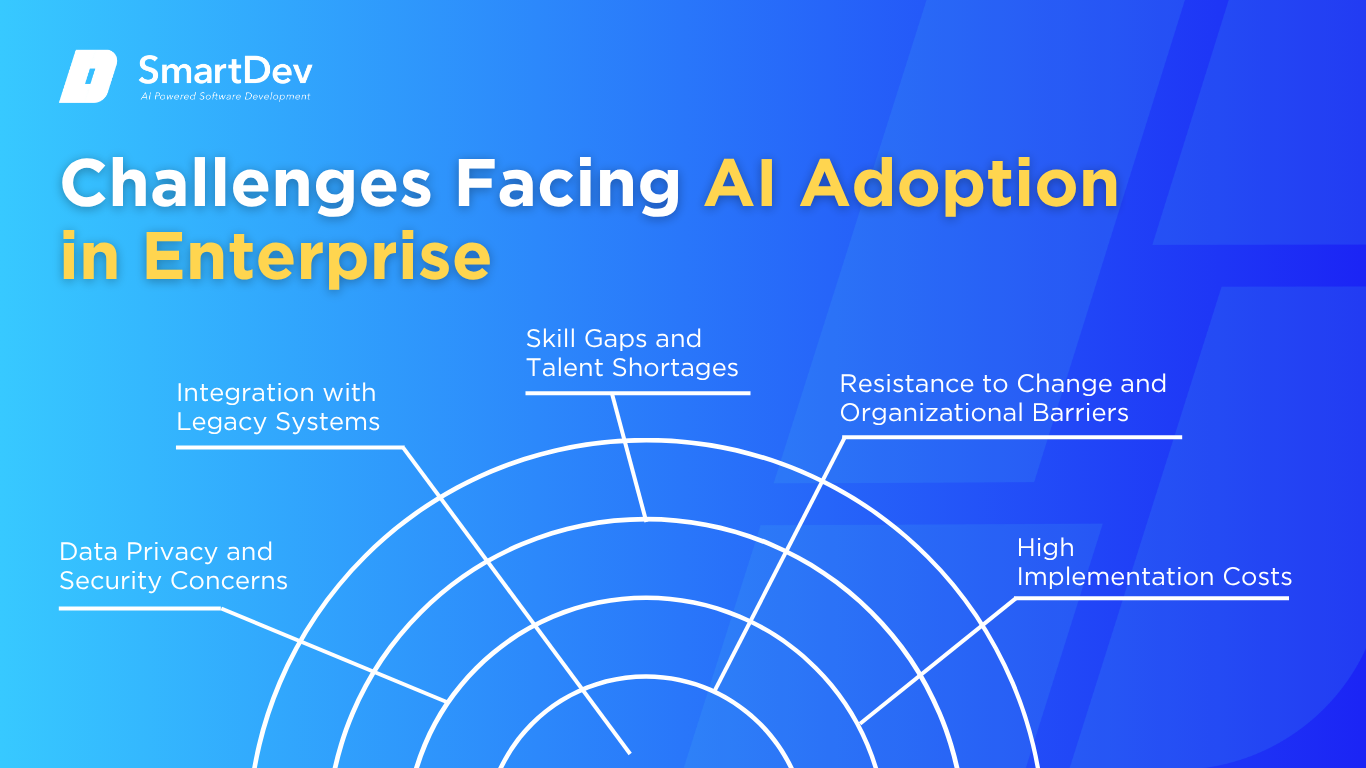
1. Data Privacy and Security Concerns
AI systems rely on large datasets, often including sensitive personal or business data. This raises significant concerns about data privacy and security, especially with increasing regulations like GDPR and CCPA. Enterprises must ensure that AI systems comply with data protection laws and safeguard customer information.
Investing in robust data encryption, privacy controls, and ethical AI practices is crucial to maintaining customer trust. Without proper security measures, AI implementation could expose businesses to data breaches, legal repercussions, and reputational damage.
2. Integration with Existing Systems
Many enterprises have legacy systems that are not designed to work seamlessly with modern AI tools. Integrating AI with existing infrastructure can be complex, time-consuming, and expensive. Organizations may need to upgrade their systems or invest in new technologies to ensure compatibility with AI solutions.
Successful AI implementation requires a clear integration strategy and the right technical expertise. Enterprises must carefully plan how AI will fit into their existing systems, ensuring that new solutions complement or replace outdated technology while minimizing disruption.
3. Skill Gaps and Talent Shortages
The complexity of AI technologies means that companies need employees with specialized skills in data science, machine learning, and AI implementation. However, there is a global shortage of AI talent, making it difficult for many enterprises to build and maintain AI-driven initiatives.
To overcome this, companies need to invest in upskilling their existing workforce, partnering with AI providers, or hiring external experts. Cultivating a culture of continuous learning and developing strategic partnerships can help bridge the talent gap and ensure long-term success in AI adoption.
4. Resistance to Change and Organizational Barriers
Introducing AI into enterprise operations often requires significant organizational changes. Employees may resist AI adoption due to fears of job displacement or a lack of understanding of how AI works. Overcoming this resistance is crucial for successful implementation.
Effective change management is key to overcoming organizational barriers. Clear communication, training, and leadership support are essential to help employees embrace AI and integrate it into their daily workflows.
5. High Implementation Costs
The upfront costs of implementing AI can be substantial, particularly for large enterprises with complex needs. From purchasing AI software to training employees and upgrading infrastructure, the financial investment required can be a significant barrier for some organizations.
However, businesses should view AI adoption as a long-term investment that will ultimately lead to cost savings and improved efficiency. Companies must weigh the upfront costs against the potential benefits of AI, such as increased productivity, reduced operational costs, and enhanced customer experiences.
Specific Applications of AI in Enterprise

1. AI-Powered Customer Service: Chatbots and Virtual Assistants
AI-driven chatbots and virtual assistants are reshaping how enterprises manage customer service. These systems utilize NLP to understand and respond to customer inquiries in real time. They are capable of handling a wide range of tasks, from answering FAQs to processing simple transactions, which allows businesses to provide 24/7 support while reducing the workload on human agents.
AI models are trained on large datasets of previous customer interactions, enabling them to continually improve their responses and personalize interactions. They can identify customer intent, recommend products, or direct queries to appropriate departments, making customer service more efficient. As a result, companies see faster response times, higher customer satisfaction, and reduced operational costs.
L’Oréal employs AI-powered chatbots to assist customers with personalized beauty recommendations and to manage product queries. These chatbots help reduce response time during high-demand periods and improve the shopping experience, contributing to higher sales and customer engagement.
2. Predictive Analytics for Business Intelligence
AI-driven predictive analytics are helping enterprises make smarter decisions by analyzing past data to forecast future trends. These AI systems analyze vast amounts of historical data from various business processes (e.g., sales, marketing, finance) to identify patterns and make predictions about future performance, customer behavior, or market trends.
Machine learning algorithms learn from historical data to improve their predictions over time. These predictions enable businesses to optimize inventory, forecast demand, and even identify opportunities for growth. The strategic value lies in making data-driven decisions that can enhance business operations, reduce risks, and improve customer satisfaction.
Walmart uses AI-based predictive analytics to optimize its inventory management and forecast demand across its vast network of stores. By accurately predicting the need for specific products, Walmart can reduce stockouts and excess inventory, leading to cost savings and improved product availability for customers.
3. Robotic Process Automation (RPA) for Operational Efficiency
Robotic Process Automation (RPA) powered by AI is revolutionizing the way enterprises manage repetitive tasks. RPA automates rule-based tasks such as data entry, invoice processing, and document handling, reducing the need for manual labor and increasing the speed and accuracy of these processes.
AI-enhanced RPA systems can handle more complex tasks by integrating machine learning, allowing them to adapt to changing environments and learn from new data. This increases operational efficiency, reduces human errors, and frees up employees to focus on more strategic activities.
Unilever uses AI-driven RPA to streamline its supply chain management and invoice processing. By automating these manual tasks, Unilever has reduced operational costs, improved accuracy, and enhanced the overall efficiency of its business operations.
4. AI for Fraud Detection and Cybersecurity
AI is playing an essential role in protecting enterprises from fraud and cybersecurity threats. AI systems are capable of analyzing transaction data, network traffic, and user behavior in real-time to detect anomalies that may indicate fraudulent activity or a security breach.
Machine learning models continuously improve by learning from new data, allowing them to detect emerging threats and patterns. These AI systems provide proactive defense mechanisms that help businesses prevent financial losses, secure sensitive data, and ensure compliance with regulatory standards.
PayPal uses AI for real-time fraud detection by analyzing transaction data to identify suspicious patterns. This system helps prevent fraudulent transactions and protects both buyers and sellers, maintaining the integrity of the platform. As a result, PayPal has been able to significantly reduce fraudulent activities while ensuring a safe payment experience for users.
5. AI for Talent Acquisition and HR Analytics
AI applications in Human Resources (HR) are improving recruitment processes by automating candidate screening, interviews, and employee performance analysis. AI tools use machine learning to analyze resumes, match candidates to suitable job roles, and assess cultural fit based on historical hiring data.
These tools help HR teams streamline the recruitment process, reduce bias, and make more informed hiring decisions. Additionally, AI-driven analytics can evaluate employee performance, predict turnover, and provide insights into workforce planning and engagement, helping businesses build stronger teams.
IBM uses AI to enhance its talent acquisition process by using an AI-powered system to analyze resumes and match candidates to the right job openings. This has reduced the time spent on recruitment and improved the quality of hires, contributing to a more efficient HR process.
6. AI-Powered Marketing Automation
AI is transforming marketing by automating campaign management, customer segmentation, and personalized recommendations. AI systems analyze customer data, including browsing history, demographics, and past interactions, to create highly targeted marketing strategies that resonate with individual consumers.
AI can optimize campaigns in real-time, testing different strategies and adjusting them for maximum engagement and conversion. By automating these processes, businesses can deliver personalized content to the right audience at the right time, improving customer acquisition and retention rates.
Netflix uses AI to personalize recommendations for its users by analyzing viewing history and preferences. This personalized approach has contributed significantly to customer satisfaction and retention, driving Netflix’s continued growth and success in the competitive streaming industry.
Need Expert Help Turning Ideas Into Scalable Products?
Partner with SmartDev to accelerate your software development journey — from MVPs to enterprise systems.
Book a free consultation with our tech experts today.
Let’s Build TogetherExamples of AI in Enterprise
AI is becoming a critical tool in enterprises across industries, helping organizations automate processes, make data-driven decisions, and improve customer experiences. Below are three well-known examples of AI applications in enterprise settings that showcase its diverse impact, from business intelligence to customer engagement.
Real-World Case Studies

1. Salesforce: AI-Powered Customer Relationship Management (CRM)
Salesforce, a global leader in CRM solutions, integrates AI through its Einstein platform to enhance customer relationship management. Einstein uses machine learning and natural language processing to analyze customer data and provide actionable insights. This allows businesses to predict customer behavior, automate tasks, and create personalized customer interactions.
With AI, Salesforce automates repetitive tasks such as lead scoring, sales forecasting, and customer support ticket prioritization. It also helps identify high-value opportunities and recommends the best actions for sales teams to take. Businesses leveraging Salesforce AI have seen improved sales productivity, higher customer satisfaction, and increased conversion rates.
2. Amazon: AI-Driven Supply Chain Optimization
Amazon uses AI extensively across its vast logistics network to optimize its supply chain and inventory management. Machine learning algorithms analyze real-time data to predict demand, monitor inventory levels, and improve delivery routes. This helps Amazon maintain an efficient, cost-effective system that ensures fast delivery times, even during high-demand periods like holiday seasons.
AI also plays a role in Amazon’s fulfillment centers, where robots and automated systems work alongside human employees to sort packages and manage inventory. These AI-driven systems improve warehouse efficiency and reduce human error, contributing to Amazon’s ability to offer same-day or next-day delivery to customers globally.
3. Netflix: AI for Content Personalization and Recommendations
Netflix employs AI to deliver personalized content recommendations to its millions of subscribers. By analyzing users’ viewing history, preferences, and engagement patterns, Netflix’s machine learning algorithms predict what shows or movies a user is most likely to enjoy. The more data the system gathers, the better it can tailor recommendations, which keeps users engaged and encourages longer viewing times.
AI also helps Netflix decide which original content to produce, as it uses data insights to forecast the types of shows and movies that will resonate with viewers. This data-driven approach has contributed significantly to Netflix’s growth by improving user retention and content engagement.
4. IBM: Watson for AI-Driven Business Intelligence
IBM Watson, a leading AI-driven platform, is widely used in enterprises for business intelligence and decision-making. Watson’s AI capabilities allow businesses to analyze large datasets, uncover hidden patterns, and gain actionable insights for strategic decision-making. It uses natural language processing and machine learning algorithms to understand complex data and provide accurate predictions.
For example, Watson has been used by companies like H&R Block to enhance customer service by providing personalized financial advice. The system analyzes customers’ financial data to make recommendations and answer questions, enabling the company to offer more targeted, efficient services to its clients. IBM Watson has become a powerful tool for enterprises looking to leverage AI to drive smarter, data-driven decisions.
Innovative AI Solutions
AI-Driven Innovations Transforming Enterprise
Emerging Technologies in AI for Enterprise
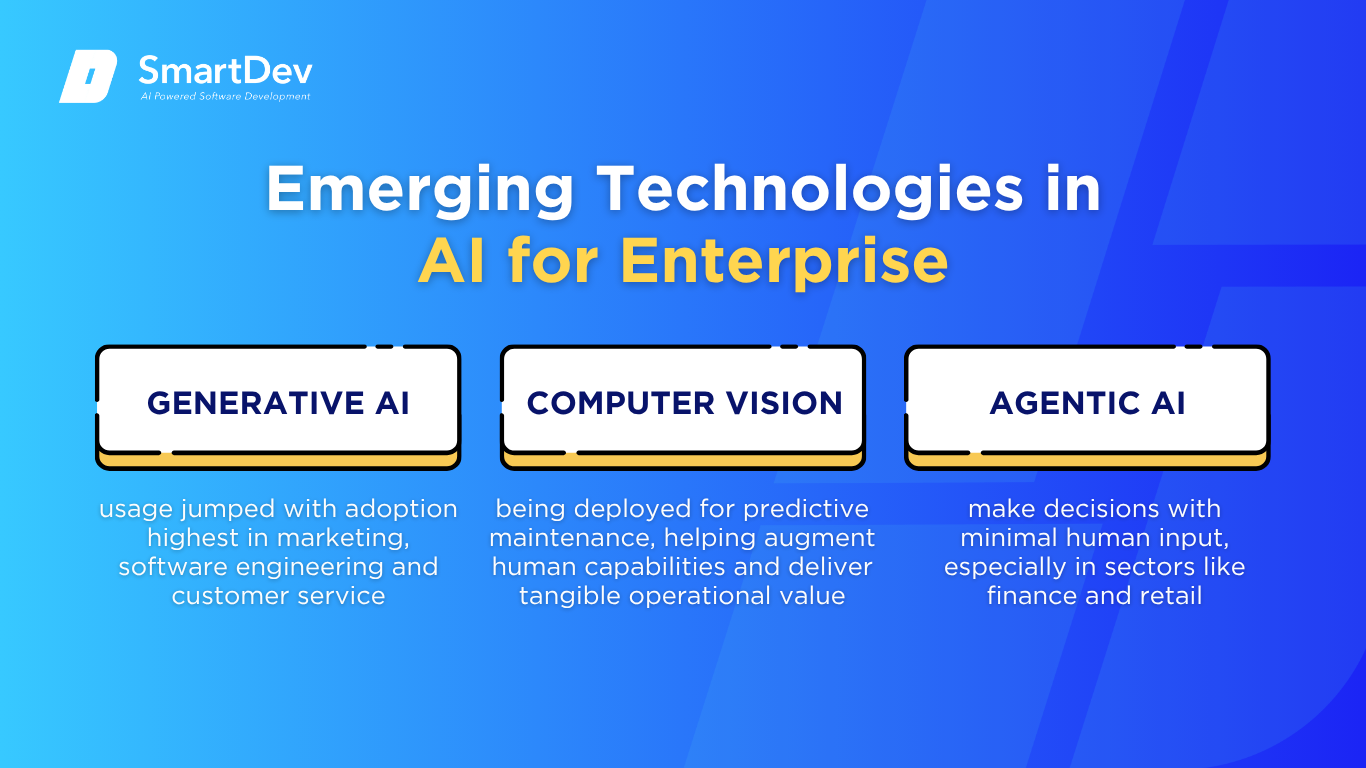
Enterprises increasingly leverage generative AI and computer vision to streamline core functions. According to McKinsey, generative AI usage jumped from 33 % in 2023 to 71 % in 2024 – with adoption highest in marketing, software engineering, and customer service.
Computer vision is being deployed for predictive maintenance, such as sensor-based failure detection in manufacturing, enabling firms like Siemens to reduce unplanned downtime by 25 % . These technologies help augment human capabilities and deliver tangible operational value.
Leading companies are also embracing agentic AI – autonomous systems that learn, decide, and act across workflows. Recent FT reporting highlights the rise of agentic platforms that make decisions with minimal human input, especially in sectors like finance and retail. Walmart’s “super agents” like Sparky illustrate how generative + agentic AI can transform customer experience and backend operations.
AI’s Role in Sustainability Efforts
AI is reshaping sustainability strategies in enterprise by optimizing operations to minimize waste and reduce emissions. Predictive analytics tools enable companies to forecast supply chain disruptions and demand patterns, reducing the risk of excess inventory and energy-heavy logistics. For instance, AI-driven inventory systems in retail and manufacturing help prevent overstocking and cut down on perishable waste, saving both costs and environmental strain.
Enterprise-grade smart systems powered by AI also improve energy management within large facilities. They automatically adjust HVAC, lighting, and equipment usage based on real-time data, significantly lowering energy consumption. In commercial real estate, AI helps select sustainable materials and plan layouts that enhance airflow and daylight exposure, reducing long-term operational emissions. These applications are turning AI into a key driver of green transformation across enterprise-level operations.
How to Implement AI in Enterprise
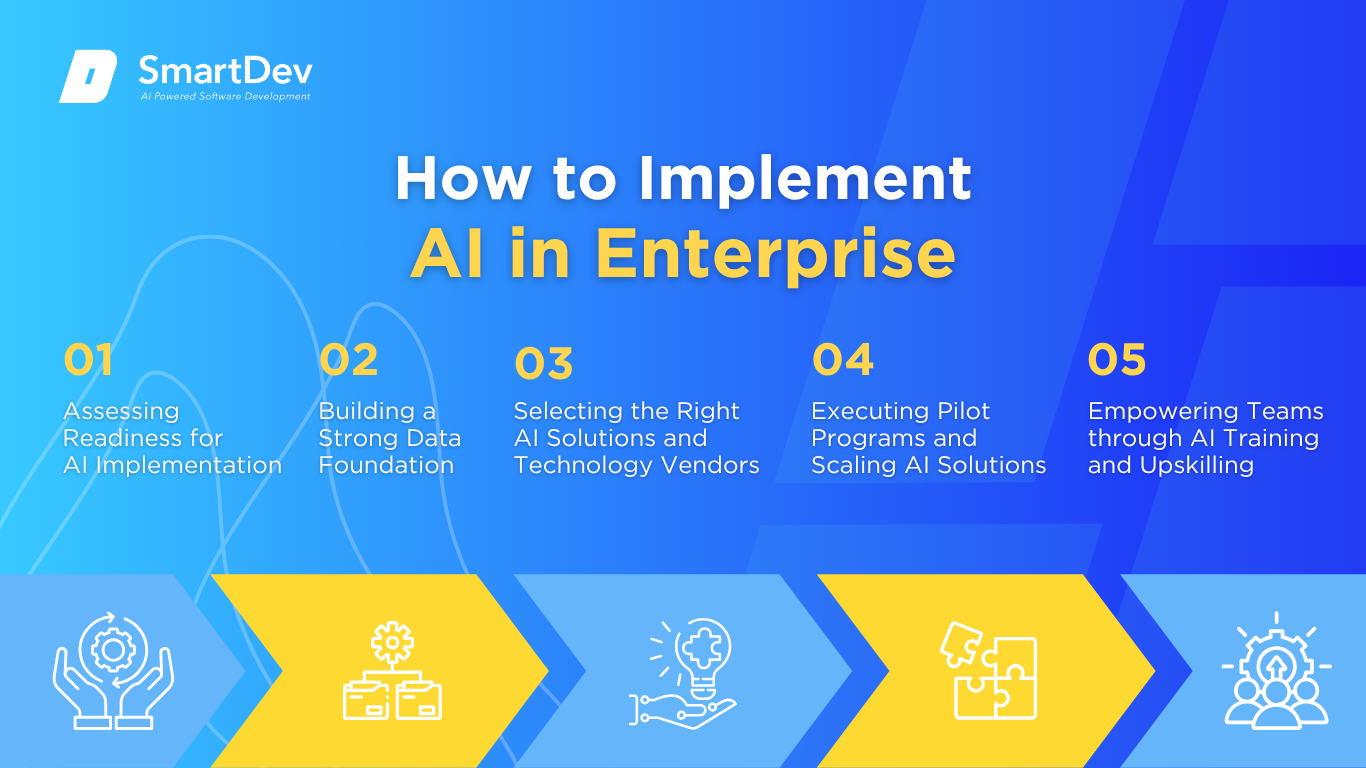
Step 1: Assessing Readiness for AI Adoption
Before diving into AI, enterprises must take a hard look at where AI can bring the most value. Start by mapping your organization’s processes, like customer service, finance operations, supply chain, and IT support and pinpoint tasks that are repetitive, data-heavy, or bottleneck-prone. These are typically the best candidates for automation or enhancement through AI.
It’s equally important to evaluate your internal capacity for AI adoption. Do you have the computing infrastructure, data accessibility, and leadership support to make AI successful? Consider launching a readiness audit, including skills assessments and change management planning. Aligning teams early will reduce friction and build momentum when AI solutions are introduced.
Step 2: Building a Strong Data Foundation
AI thrives on data, but not just any data. Enterprises need structured, clean, and reliable information flowing in from multiple touchpoints: customer interactions, financial transactions, supply chain logs, and internal systems. The first step is auditing your data pipeline: where it lives, how it’s collected, and whether it’s consistent and usable.
Once your data landscape is understood, prioritize data cleaning and governance. AI models trained on poor-quality or fragmented data tend to produce unreliable outcomes. Establishing strong security protocols and ensuring compliance with regulations like GDPR or CCPA is also critical. With a robust data foundation, your AI can start delivering precise, actionable insights.
Step 3: Choosing the Right Tools and Vendors
Choosing the right AI tools is more than a tech decision, it’s a strategic one. Enterprises should seek platforms that integrate smoothly with current systems and support their specific use cases, whether that’s customer support chatbots, document processing, or predictive analytics. Look for scalable tools that offer transparency, explainability, and vendor support.
Equally important is the vendor relationship. Choose partners who understand your industry’s nuances and can help you navigate compliance, scale, and change management. A vendor with proven success in your vertical can offer insights and roadmaps that accelerate your implementation while avoiding common pitfalls.
Step 4: Pilot Testing and Scaling Up
AI shouldn’t be rolled out across your entire organization all at once. Instead, run pilot programs in specific departments or workflows, like using an AI-powered agent to triage IT tickets or automate invoice processing. These pilots allow you to test AI in a controlled environment, refine the model, and gather key performance metrics.
If the pilot proves effective, scale the solution gradually across teams or geographies. Make sure to collect feedback from end users and incorporate changes along the way. This phased rollout helps build internal trust in AI and ensures that technical and cultural adoption progress hand in hand.
Step 5: Training Teams for Successful Implementation
Technology is only half the equation, people make up the other half. For AI to succeed, your teams need to be confident and capable using it. Provide training on how AI works, how to interpret outputs, and how to collaborate with AI in daily tasks. Leading enterprises are even building internal AI academies to foster literacy across departments.
It’s not just about technical skills either. Helping employees shift their mindset to see AI as a collaborator rather than a competitor builds long-term resilience. Open communication, clear role definitions, and showcasing early success stories will drive broader buy-in across the company.
Measuring the ROI of AI in Enterprise
Key Metrics to Track Success
Understanding the return on investment (ROI) from AI initiatives starts with tracking the right metrics. For many enterprises, the most immediate impact is seen in operational efficiency with faster response times, reduced processing delays, and streamlined workflows. For instance, companies often measure reductions in turnaround time for tasks like invoice approvals, IT ticket handling, or customer service queries.
Cost savings is another key performance indicator. AI can automate manual, repetitive tasks, freeing up employees for more strategic work. This doesn’t necessarily mean job cuts; instead, it allows teams to do more with less. Improved accuracy and fewer errors also translate to fewer reworks, refunds, or compliance penalties. Other ROI indicators include revenue growth from improved customer experiences, enhanced forecasting accuracy, and even better employee satisfaction due to AI taking over mundane tasks.
Case Studies Demonstrating ROI
Let’s look at real-world examples to understand what AI ROI can look like in practice. In one large South Korean enterprise, the deployment of AI-powered document processing in the finance department led to a reduction in processing time of over 80%, along with a significant drop in compliance errors. The system used intelligent agents to analyze and classify expenses, improving both speed and accuracy in financial reporting.
Siemens, in the manufacturing space, implemented AI-driven predictive maintenance tools. By using computer vision and machine learning to monitor equipment health, they reduced unplanned downtime by 25%, a result that not only saved millions in lost productivity but also extended the lifespan of expensive machinery.
Meanwhile, Walmart’s adoption of “AI super agents” for customer service helped consolidate fragmented support systems. While full figures are still emerging, early indicators point to improved customer satisfaction, faster resolution times, and better internal efficiency. Their AI transformation strategy is expected to deliver long-term cost savings and e-commerce growth.
Common Pitfalls and How to Avoid Them
Despite the potential of AI, many enterprises stumble during implementation. A common mistake is pursuing AI for the sake of innovation, rather than solving a specific business problem. This often leads to fragmented, siloed projects that don’t scale or deliver clear value. To avoid this, enterprises should align AI initiatives with strategic goals and measurable outcomes from day one.
Another pitfall is underestimating the importance of data quality. AI relies on clean, consistent, and comprehensive data, poor inputs lead to unreliable outputs. Companies also often overlook the human side of implementation. Resistance to change, lack of training, or insufficient communication can undermine even the most sophisticated systems. A successful rollout requires a balance of technical precision and thoughtful change management to truly deliver ROI.
Future Trends of AI in Enterprise
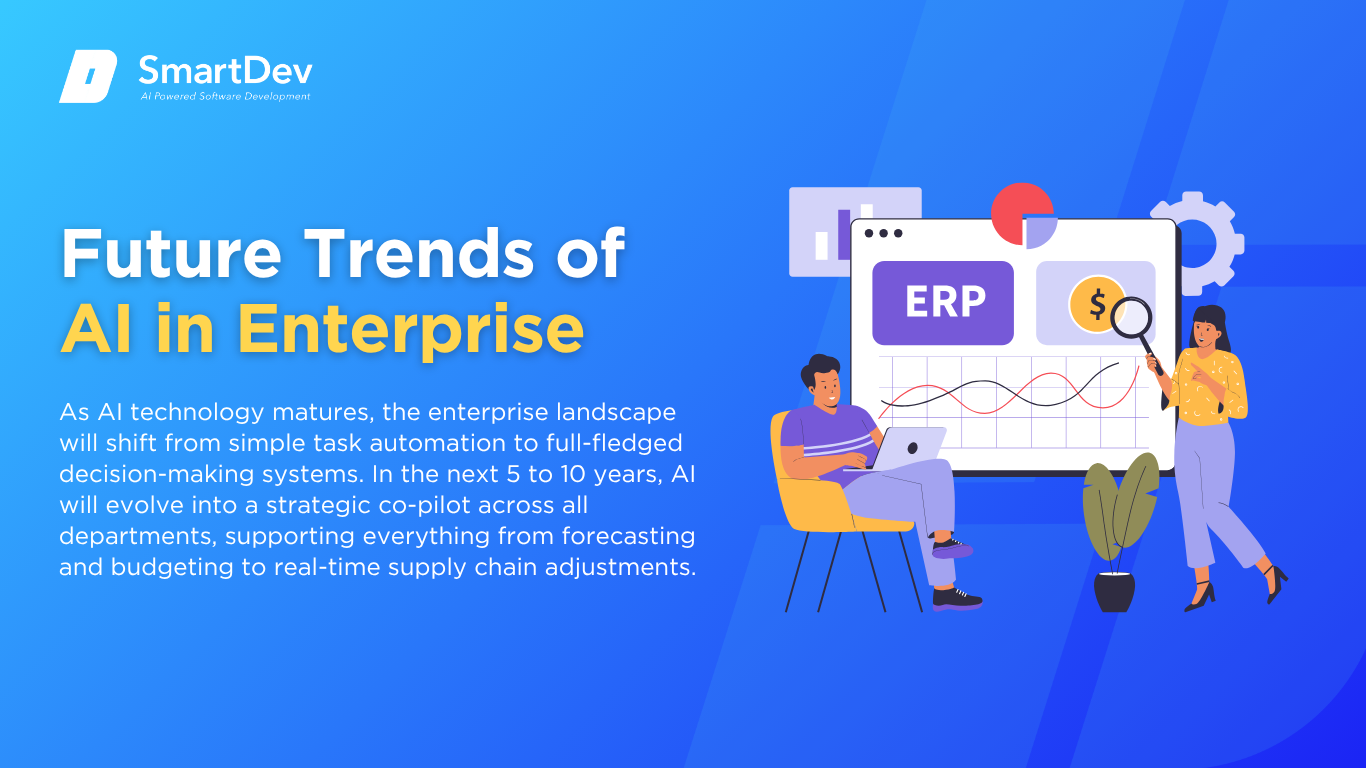
Predictions for the Next Decade
As AI technology matures, the enterprise landscape will shift from simple task automation to full-fledged decision-making systems. In the next 5 to 10 years, AI will evolve into a strategic co-pilot across all departments, supporting everything from forecasting and budgeting to real-time supply chain adjustments. McKinsey predicts that by 2028, a significant portion of enterprise processes will be handled by agentic AI, capable of autonomous decision-making with minimal human oversight.
We will also see deeper integration of AI with emerging technologies like digital twins, blockchain, and edge computing. These integrations will enable enterprises to simulate entire business operations in real time, run predictive scenarios, and optimize resource allocation proactively. AI models will become increasingly self-learning and adaptable, meaning businesses won’t need to retrain them as frequently – a game-changer in terms of agility and scalability.
How Businesses Can Stay Ahead of the Curve
To stay competitive in this AI-powered future, businesses need to embed AI into both strategy and culture. That starts with leadership, executives must champion AI adoption and set the tone for cross-functional collaboration. Companies like PwC, Mastercard, and IKEA have already created internal AI academies and cross-department innovation labs to institutionalize learning and experimentation.
Staying ahead also means investing in modular, open AI platforms that can evolve as your business grows. Enterprises that adopt flexible tools, prioritize data governance, and embrace ethical AI principles will be better equipped to scale. More importantly, organizations that treat AI as a strategic enabler will unlock long-term value and resilience. The future belongs to companies that are not just using AI but building with it at the core.
Conclusion
Key Takeaways
AI is transforming the enterprise landscape by streamlining operations, enhancing customer experiences, and driving substantial cost savings. From intelligent document processing and predictive maintenance to AI-powered agents managing customer support and IT workflows, AI technologies are reengineering how modern businesses operate at scale.
By embedding AI into core functions, enterprises can unlock greater efficiency, resilience, and strategic clarity. Those that invest in clean data foundations, employee training, and ethical governance are better positioned to realize both immediate value and long-term competitive advantage. As enterprise AI evolves into more autonomous, agentic systems, its potential to optimize decisions, reduce operational overhead, and scale innovation will only expand.
Looking ahead, businesses that move decisively, building flexible architectures and embedding AI capabilities across departments will set the pace. The future of enterprise belongs to those who turn AI from a tool into a core capability.
Moving Forward: A Strategic Approach to AI in Enterprise
If your enterprise is ready to take the next step with AI, now is the time to move with intention. Start by identifying high-impact workflows where AI can deliver immediate value, such as expense processing, supply chain forecasting, or customer support. Evaluate your current systems, data maturity, and team readiness to ensure you can deploy responsibly and at scale.
Partnering with experts like SmartDev can accelerate your journey. We help you minimize implementation risks, align AI strategies with business goals, and deploy proven solutions that drive measurable results. With tailored roadmaps and hands-on support, we make enterprise AI adoption clear, achievable, and impactful.
Don’t let competitors outpace you. Reach out today to explore how AI can transform your business operations, enhance efficiency, and future-proof your enterprise in an increasingly intelligent world.
—
References:
- More Than 80% of Enterprises Will Use Generative AI by 2026 | Gartner
- Enterprise Artificial Intelligence Market Report | Grand View Research
- The State of AI | McKinsey
- Beauty Genius: AI Beauty Virtual Assistant | L’Oréal Paris USA
- Walmart’s AI-Powered Inventory System Brightens the Holidays | Walmart Global Tech
- How AI Is Transforming Unilever Ice Cream’s End-to-End Supply Chain | Unilever
- Payment Fraud Detection Using Machine Learning | PayPal
- Recommendations Research | Netflix Research
- Optimize Your Supply Chain Processes with Generative AI on AWS | AWS Blog


